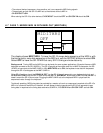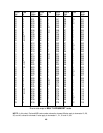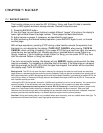
46
• The external device (sequencer, drum machine, etc.) can respond to MIDI timing signals.
• These signals go from the SR-16's MIDI out to the external device's MIDI in.
• CLOCKOUT is ON.
When slaving the SR-16 to other devices, CLOCKOUT should be OFF and CLOCK IN should be ON.
6.7 PAGE 7: MERGE MIDI IN WITH MIDI OUT (MIDITHRU)
MIDITHRU
PAGE
OFF
SETUP
MIDI
PERFORM
The display shows MIDITHRU. To have the SR-16 merge data appearing at the MIDI in with
the timing and/or note data appearing at the MIDI out, use the INC/DEC buttons to select ON.
Select OFF to have the SR-16 MIDI out carry SR-16 timing and note data only.
Background Turning MIDI out to MIDI thru can be handy for some system applications. Example: Assume a MIDI
keyboard connects to the SR-16 MIDI in. The SR-16 serves as the master clock for an MMT-8 sequencer; the SR-
16 MIDI out connnects to the MMT-8 MIDI in. With MIDITHRU set to ON, the keyboard note data will be passed
through the SR-16 and appear at the MMT-8 MIDI in.
Other SR-16 settings should be DRUM IN OFF (so the SR-16 doesn't respond to your keyboard playing) and
CLOCKOUT ON so that the SR-16 clock drives the MMT-8. DRUMOUT should also be OFF so that the MMT-8
doesn't record the SR-16 drum notes. Plugging the MMT-8 MIDI out to the keyboard MIDI in plays back the
sequenced notes through the keyboard.
Technically speaking, MIDI timing data (as provided by a master unit such as a sequencer) received at the SR-16's
MIDI in is not sent to the MIDI out. However, this will appear to be the case since the SR-16 will generate its own
timing data in response to the timing data received at its MIDI in, if CLOCK IN and CLOCK OUT are both ON.


















